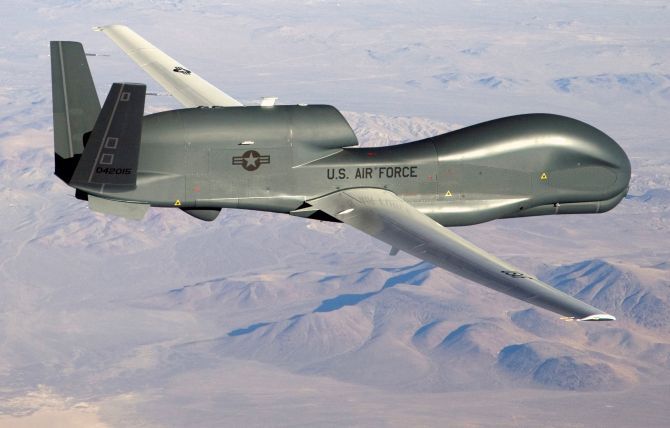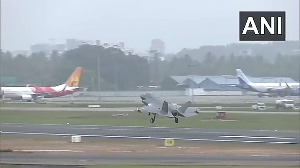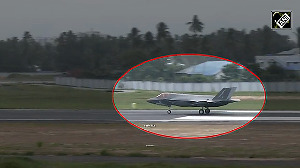The Global Hawk can carry out surveillance of a stretch of land or ocean for over 30 hours continuously, physically scanning up to 100,000 sq km each day.
Ajai Shukla reports.

Stemming from America's changing security threats is a lucrative opportunity for New Delhi to save billions of dollars on its ongoing purchase of 30 Sea Guardian unmanned aerial systems, and another 10 P-8I Poseidon multi-mission maritime aircraft for monitoring the Indian Ocean.
Instead of spending an estimated $2.5 billion on Sea Guardian drones, India could buy up to 24 far more capable, sophisticated and longer-range RQ-4 Global Hawk drones that the US air force wants to discard.
The USAF believes long-range drones are superfluous as Washington shifts attention from combating terrorism (which requires drones to track and kill terrorists) and focuses instead on building the capabilities needed to combat a new threat -- superpower adversaries Russia and China.
To save money for buying cutting-edge war fighting weapons like stealth bombers and hypersonic missiles, the USAF has reportedly proposed to the US department of defence (the Pentagon) to scrap two-thirds of its fleet of about 35 Global Hawk drones.
If the Pentagon accepts the USAF proposal that would clear the decks for India's ministry of defence to ask for the retired Global Hawk UASs under the Pentagon's 'excess defence articles' programme.
The Pentagon's decision will be known in February 2020 when it submits its final budget projections to the US congress.
The EDA programme allows the Pentagon to supply its unneeded weaponry to allies and partner countries at heavily discounted prices or even free of cost in cases where US national security objectives are being furthered.
Building India's capability as a 'net security provider' in the Indian Ocean Region is a stated US national security policy objective.
In 2005, India experienced the cost benefits of buying US equipment under the EDA programme. That year, the Pentagon sold the Indian Navy the USS Trenton -- an amphibious warfare ship, now renamed the INS Jalashwa -- for just $60 million, about a tenth of what it was worth. That price included the cost of six helicopters on the warship.
The INS Jalashwa is currently the second-biggest warship in India's navy.
The Global Hawk is classified as a 'high altitude long endurance' UAS that can carry out surveillance of a stretch of land or ocean for over 30 hours continuously, physically scanning up to 100,000 square kilometres each day -- more than the Sea Guardians that India's military is currently acquiring.
Teams of drone pilots, working in shifts, fly long-range drone missions from ground stations thousands of kilometres away, using satellite communication links.
The information the UAS picks up is transmitted to the ground station in real time, allowing the military to respond to threats immediately.
US firm Northrop Grumman, which designed and built the Global Hawk, is currently developing it into a maritime variant called the MQ-4C Triton, which is customised for oceanic surveillance.
Under the so-called broad area maritime surveillance programme, Northrop Grumman is integrating the Triton with the P-8A Poseidon for intelligence, surveillance and reconnaissance maritime missions. Joining the US, Australia, which also operates the P-8A Poseidon, has joined BAMS.
With the Indian Navy currently operating the world's largest Poseidon fleet (outside for the US navy), acquiring Global Hawks under the EDA programme and modifying them to MQ-4C Triton configuration could provide a cheap and effective BAMS solution for surveillance of the Indian Ocean.
Since 2001, a generation of US drones like the Predator, Reaper and Global Hawk has played a central role in the 'War on Terror', killing hundreds of terrorists and their supporters in Pakistan, Afghanistan, Iraq and Yemen.
But UAS are highly vulnerable to radar-based air defence systems of the kind that State adversaries deploy. This was underscored in June when Iran shot down a Global Hawk that America was operating over the Strait of Hormuz.
However, India does not intend to fly Sea Guardian drones (or Global Hawks if those are bought) over hostile airspace, but over international waters -- to monitor shipping over the vast expanses of the Indian Ocean. Therefore, the vulnerability of these UAS to radar-guided air defence weapons is not a major concern.
Asked whether it plans to approach the Pentagon for buying surplus Global Hawk drones under the EDA programme, the navy has not commented.
The Pentagon's shift from counter-terrorism to combating great-power threats from China and Russia has been laid out in the Pentagon's national defence strategy document that was published in January 2018.












